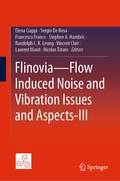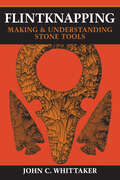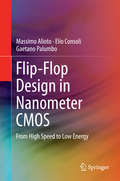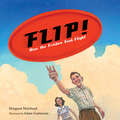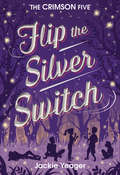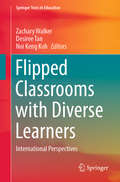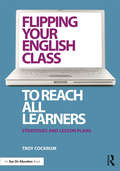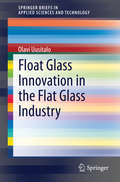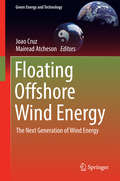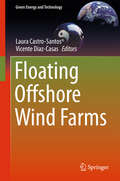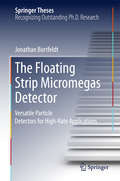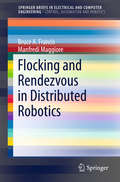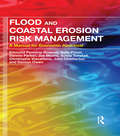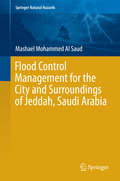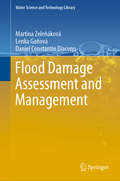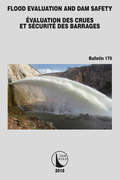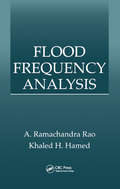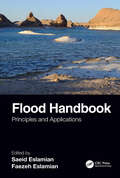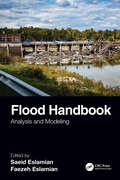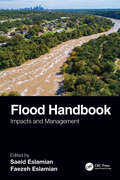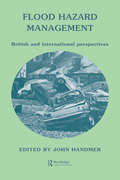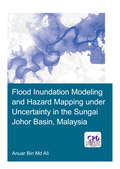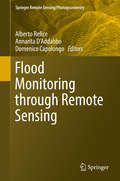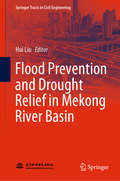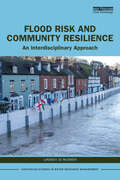- Table View
- List View
Flinovia—Flow Induced Noise and Vibration Issues and Aspects-III
by Elena Ciappi Sergio De Rosa Francesco Franco Stephen A. Hambric Randolph C. K. Leung Vincent Clair Laurent Maxit Nicolas TotaroThis volume gathers the latest advances and innovations in the field of flow-induced vibration and noise, as presented by leading international researchers at the 3rd International Symposium on Flow Induced Noise and Vibration Issues and Aspects (FLINOVIA), which was held in Lyon, France, in September 2019. It explores topics such as turbulent boundary layer-induced vibration and noise, tonal noise, noise due to ingested turbulence, fluid-structure interaction problems, and noise control techniques. The authors’ backgrounds represent a mix of academia, government, and industry, and several papers include applications to important problems for underwater vehicles, aerospace structures and commercial transportation. The book offers a valuable reference guide for all those interested in measurement, modelling, simulation and reproduction of the flow excitation and flow induced structural response.
Flintknapping: Making & Understanding Stone Tools
by John C. WhittakerA detailed, practical guide to the ancient craft of making stone tools, featuring an archaeological analysis.Flintknapping is an ancient craft enjoying a resurgence of interest among both amateur and professional students of prehistoric cultures. In this guide, John C. Whittaker offers the most detailed handbook on flintknapping currently available and the only one written from the archaeological perspective of interpreting stone tools as well as making them.Flintknapping contains detailed, practical information on making stone tools. Whittaker starts at the beginner level and progresses to discussion of a wide range of techniques. He includes information on necessary tools and materials, as well as step-by-step instructions for making several basic stone tool types. Numerous diagrams allow the reader to visualize the flintknapping process, and drawings of many stone tools illustrate the discussions and serve as models for beginning knappers.Written for a wide amateur and professional audience, Flintknapping will be essential for practicing knappers as well as for teachers of the history of technology, experimental archaeology, and stone tool analysis.“A mid-range user’s guide to flintknapping is long overdue. There have been some admirable attempts to produce such a volume, but these have been targeted at specific, fairly narrow audiences. Not so with Flintknapping. . . . [Whittaker’s] clear aim is to reach professional archaeologists as well as hobbyists. I believe he achieves this goal with incredible skill and humor. . . . I highly recommend this book to everyone interested in flintknapping.” —Plains Anthropologist“Very attractive to readers interested in ancient crafts, survival skills, or the history of technology . . . . Far superior to anything currently available.” —James C. Woods, director, The Herrett Museum, College of Southern Idaho
Flip-Flop Design in Nanometer CMOS
by Massimo Alioto Elio Consoli Gaetano PalumboThis book provides a unified treatment of Flip-Flop design and selection in nanometer CMOS VLSI systems. The design aspects related to the energy-delay tradeoff in Flip-Flops are discussed, including their energy-optimal selection according to the targeted application, and the detailed circuit design in nanometer CMOS VLSI systems. Design strategies are derived in a coherent framework that includes explicitly nanometer effects, including leakage, layout parasitics and process/voltage/temperature variations, as main advances over the existing body of work in the field. The related design tradeoffs are explored in a wide range of applications and the related energy-performance targets. A wide range of existing and recently proposed Flip-Flop topologies are discussed. Theoretical foundations are provided to set the stage for the derivation of design guidelines, and emphasis is given on practical aspects and consequences of the presented results. Analytical models and derivations are introduced when needed to gain an insight into the inter-dependence of design parameters under practical constraints. This book serves as a valuable reference for practicing engineers working in the VLSI design area, and as text book for senior undergraduate, graduate and postgraduate students (already familiar with digital circuits and timing).
Flip! How the Frisbee Took Flight
by Margaret MuirheadThis charming picture book biography about the inventor of the Frisbee follows the twists and turns of innovation and highlights the persistence it takes to succeed. Fred Morrison is credited with inventing this classic toy, but for centuries folks have been flipping for flying discs. Ancient Greeks flicked discs, and beginning in the 1920s, college kids at Yale University were tossing pie tins. Fred's invention quest began in 1932 after tossing a tin popcorn lid around the backyard. For more than twenty years, Fred and his wife, Lu, tried and failed to perfect a flying-disc concept. Eventually they created what we know today as the Frisbee. Fun and fact-filled, this Frisbee origin story is sure to delight sports and STEM fans alike.
Flip the Silver Switch (The Crimson Five #2)
by Jackie YeagerThe Crimson Five are headed to the Piedmont Global Championships in Quebec, where they'll compete against the best inventor teams in the world. Kia and her New York teammates are excited to share a new amazing invention — but they're blind-sided with another task to solve, with just two weeks to do it!As the team struggles with a lack of creativity, rumors leave The Crimson Five questioning everything about each other. Kia knows she and her team must come together like never before in order to win a coveted spot on the Swirl and Spark Creativity Tour, but tragedy threatens to derail all that they've built.The Crimson Five are together again.Because sometimes it takes a whole team to help you see things clearly.
Flipped Classrooms with Diverse Learners: International Perspectives (Springer Texts in Education)
by Noi Keng Koh Zachary Walker Desiree TanThis book addresses the background of classroom flipping, explores the theoretical underpinnings for why flipping works, and shares current success stories in practice. It provides diverse international examples of classroom flipping for all ages, includes discussions of the authors’ studies in the context of the existing research, and illustrates the impact that classroom flipping has had across a range of educational settings instead of focusing on a specific domain or learner context. Intended as a handbook for practitioners, the analysis of commonly used, highly effective techniques for learners of various ages fills a major gap in the literature. It offers a valuable resource for educators, helping them make the flipped learning experience an impactful and meaningful one.
Flipping Your English Class to Reach All Learners: Strategies and Lesson Plans
by Troy CockrumLearn how flipping your English language arts classroom can help you reach students of different abilities, improve classroom management, and give you more time to interact with each student. This practical book shows why flipped classrooms are effective and how they work. You will find out how to flip your instruction in writing, reading, language, and speaking and listening while meeting the Common Core State Standards. A variety of step-by-step lesson plans are provided.
Float Glass Innovation in the Flat Glass Industry
by Olavi UusitaloA thorough industry analysis is of utmost importance for a study on the impact of technological changes on industry structure. This book evaluates the consequences of a vaguely chosen level of an industry analysis. Too broad a definition of the industry may disaggregate sub-industries, processing industries and international aspects. This is illustrated by revisiting an industry study upon which the dominant design model was based. Readers will see and understand the consequences of too broadly defined industries together with quantitative research approach can have. The book argues that the nature of the industry should define the level of the analysis. This is done by revisiting the flat glass industry study, on which Anderson and Tushman's (1990) dominant design model is partly based. In their study Anderson and Tushman defined the flat glass industry based on four-digit SIC codes. It is argued that this definition was too broad and it disaggregated important sub-industries, processing industries and international aspects. This study uses more accurate analysis in five-digit SIC codes. The empirical findings of this study and Anderson and Tushman's study are different. Their broader industry definition revealed only the flat glass industry not two sub-industries: plate glass and sheet glass. According to this study the nature of the industry should define the level of the analysis and performance parameter should defined be based on effectiveness instead of efficiency of the innovation. As a consequence of these clarifications this study regards contrary to Anderson and Tushman float glass as the dominant design.
Floating Offshore Wind Energy
by Joao Cruz Mairead AtchesonThis book provides a state-of-the-art review of floating offshore wind turbines (FOWT). It offers developers a global perspective on floating offshore wind energy conversion technology, documenting the key challenges and practical solutions that this new industry has found to date. Drawing on a wide network of experts, it reviews the conception, early design stages, load & structural analysis and the construction of FOWT. It also presents and discusses data from pioneering projects. Written by experienced professionals from a mix of academia and industry, the content is both practical and visionary. As one of the first titles dedicated to FOWT, it is a must-have for anyone interested in offshore renewable energy conversion technologies.
Floating Offshore Wind Farms
by Laura Castro-Santos Vicente Diaz-CasasThis book provides an overview of floating offshore wind farms and focuses on the economic aspects of this renewable-energy technology. It presents economic maps demonstrating the main costs, and explores various important aspects of floating offshore wind farms. It examines topics including offshore wind turbines, floating offshore wind platforms, mooring and anchoring, as well as offshore electrical systems. It is a particularly useful resource in light of the fact that most water masses are deep and therefore not suitable for fixed offshore wind farms. A valuable reference work for students and researchers interested in naval and ocean engineering and economics, this book provides a new perspective on floating offshore wind farms, and makes a useful contribution to the existing literature.
The Floating Strip Micromegas Detector
by Jonathan BortfeldtThis book discusses a novel and high-rate-capable micro pattern gaseous detector of the Micromegas (MICRO-MEsh GAS detector) type. It provides a detailed characterization of the performance of Micromegas detectors on the basis of measurements and simulations, along with an in-depth examination of analysis and reconstruction methods. The accurate and efficient detection of minimum ionizing particles in high-rate background environments is demonstrated. The excellent performance determined here for these lightweight detectors will make possible the live medical imaging of a patient during ion-beam treatment.
Flocking and Rendezvous in Distributed Robotics
by Manfredi Maggiore Bruce A. FrancisThis brief describes the coordinated control of groups of robots using only sensory input - and no direct external commands. Furthermore, each robot employs the same local strategy, i. e. , there are no leaders, and the text also deals with decentralized control, allowing for cases in which no single robot can sense all the others. One can get intuition for the problem from the natural world, for example, flocking birds. How do they achieve and maintain their flying formation? Recognizing their importance as the most basic coordination tasks for mobile robot networks, the brief details flocking and rendezvous. They are shown to be physical illustrations of emergent behaviors with global consensus arising from local interactions. The authors extend the consideration of these fundamental ideas to describe their operation in flying robots and prompt readers to pursue further research in the field. Flocking and Rendezvous in Distributed Robotics will provide graduate students a firm grounding in the subject, while also offering an authoritative reference work for more experienced workers seeking a brief but thorough treatment of an area that has rapidly gained in interest.
Flood and Coastal Erosion Risk Management: A Manual for Economic Appraisal
by Edmund Penning-Rowsell Sally Priest Dennis Parker Joe Morris Sylvia Tunstall Christophe Viavattene John Chatterton Damon OwenA new ‘Multi-Coloured Manual' This book is a successor to and replacement for the highly respected manual and handbook on the benefits of flood and coastal risk management, produced by the Flood Hazard Research Centre at Middlesex University, UK, with support from Defra and the Environment Agency. It builds upon a previous book known as the "multi-coloured manual" (2005), which itself was a synthesis of the blue (1977), red (1987) and yellow manuals (1992). As such it expands and updates this work, to provide a manual of assessment techniques of flood risk management benefits, indirect benefits, and coastal erosion risk management benefits. It has three key aims. First it provides methods and data which can be used for the practical assessment of schemes and policies. Secondly it describes new research to update the data and improve techniques. Thirdly it explains the limitations and complications of Benefit-Cost Analysis, to guide decision-making on investment in river and coastal risk management schemes.
Flood Control Management for the City and Surroundings of Jeddah, Saudi Arabia
by Mashael Mohammed Al SaudDuring the past years, Saudi Arabia has been affected by particularly severe torrential rains and floods. This book presents an in-depth and all-encompassing study on the floods that occurred in the Jeddah area in 2009 and 2011, including water-flow mechanisms, state-of-the-art techniques for flood assessment, flood control and appropriate management approaches. It highlights a number of methods and concepts that can be applied in similar areas in Saudi Arabia in order to reduce and mitigate the impact of torrential rains and floods.
Flood Damage Assessment and Management (Water Science and Technology Library #94)
by Martina Zeleňáková Lenka Gaňová Daniel Constantin DiaconuThis book presents state-of-the-art, essential methods and tools for flood risk assessment and management. The costs of damage caused by extreme weather events, among which floods are a major category, are rapidly rising, both globally and across Europe. The scope and scale of flood episodes point to the need for comprehensive proposals, including the implementation of flood protection measures in areas exposed to flood risk. This book is dedicated to flood damage assessment, and addresses the management of social, economic and environmental damage. It develops a general methodology for flood risk assessment and presents a range of effective flood protection methods in keeping with the objectives of flood risk management. As such, it offers a valuable resource for young researchers, academics, lecturers and water management practitioners alike.
Flood Evaluation and Dam Safety (ICOLD Bulletins Series #170)
by Nathalie SchaunerHydrology and dams are two fields that are obviously closely related. Four bulletins have so far been published by the Committee: Selection of Design Flood – Current methods, Dams and Floods – Guidelines and cases histories, Role of Dams in Flood Mitigation – A review and Integrated Flood Management. These bulletins have essentially addressed floods, the risks they represent and their significance for the concerned populations. The present Bulletin deviates slightly from this path, adopting a somewhat more technical perspective. The text consists of three chapters, conceived to be accessible to the practitioners.
Flood Frequency Analysis
by A. Ramachandra Rao Khaled H. HamedAfter five decades, the field of Statistical Hydrology continues to evolve and remains a very active area of investigation. Researchers continue to examine various distributions, methods of estimation of parameters, and problems related to regionalization. However, much of this research appears in journals and reports and usually in a form not easi
Flood Handbook: Principles and Applications
by Saeid Eslamian and Faezeh EslamianFloods are difficult to prevent but can be managed in order to reduce their environmental, social, cultural, and economic impacts. Flooding poses a serious threat to life and property, and therefore it’s very important that flood risks be taken into account during any planning process. This handbook presents different aspects of flooding in the context of a changing climate and across various geographical locations. Written by experts from around the world, it examines flooding in various climates and landscapes, taking into account environmental, ecological, hydrological, and geomorphic factors, and considers urban, agriculture, rangeland, forest, coastal, and desert areas. Features Presents the main principles and applications of the science of floods, including engineering and technology, natural science, as well as sociological implications. Examines flooding in various climates and diverse landscapes, taking into account environmental, ecological, hydrological, and geomorphic factors. Considers floods in urban, agriculture, rangeland, forest, coastal, and desert areas Covers flood control structures as well as preparedness and response methods. Written in a global context, by contributors from around the world.
Flood Handbook: Analysis and Modeling
by Saeid Eslamian and Faezeh EslamianFloods are difficult to prevent but can be managed in order to reduce their environmental, social, cultural, and economic impacts. Flooding poses a serious threat to life and property, and therefore it’s very important that flood risks be taken into account during any planning process. This handbook presents different aspects of flooding in the context of a changing climate and across various geographical locations. Written by experts from around the world, it examines flooding in various climates and landscapes, taking into account environmental, ecological, hydrological, and geomorphic factors, and considers urban, agricultural, rangeland, forest, coastal, and desert areas. Features: Presents the main principles and applications of the science of floods, including engineering and technology, natural science, and sociological implications. Considers floods in urban, agricultural, rangeland, forest, coastal, and desert areas. Covers flood control structures as well as preparedness and response methods. Written in a global context, by contributors from around the world.
Flood Handbook: Impacts and Management
by Saeid Eslamian and Faezeh EslamianFloods are difficult to prevent but can be managed in order to reduce their environmental, social, cultural, and economic impacts. Flooding poses a serious threat to life and property, and therefore it’s very important that flood risks be taken into account during any planning process. This handbook presents different aspects of flooding in the context of a changing climate and across various geographical locations. Written by experts from around the world, it examines flooding in various climates and landscapes, taking into account environmental, ecological, hydrological, and geomorphic factors, and considers urban, agriculture, rangeland, forest, coastal, and desert areas. Features Presents the main principles and applications of the science of floods, including engineering and technology, natural science, as well as sociological implications. Examines flooding in various climates and diverse landscapes, taking into account environmental, ecological, hydrological, and geomorphic factors. Considers floods in urban, agriculture, rangeland, forest, coastal, and desert areas Covers flood control structures as well as preparedness and response methods. Written in a global context, by contributors from around the world.
Flood Hazard Management: British And International Perspectives
by John HandmerIn some important respects floodplain management and flood hazard research is different in Britain from that in other countries. This collection of papers from a conference provides some comparisons. It covers urban flooding, institutions and policy, land use policy, hazard response, and project appraisal and risk assessment.
Flood Inundation Modeling and Hazard Mapping under Uncertainty in the Sungai Johor Basin, Malaysia (IHE Delft PhD Thesis Series)
by Anuar Bin AliFlooding can have devastating impacts on people’s livelihood, economy and the environment. An important instrument in flood management is floodplain maps, which assist land planners and local authorities in identifying flood-prone areas, and provide useful information for rescue and relief agencies for their operations. Developing floodplain maps often involves flood inundation modeling. This typically requires precipitation and stream flow data, topographic information, building a hydraulic model and calibration of its parameters. Often however, floodplain maps are built on a single model outcome without an explicit consideration of all the sources of uncertainty in the modeling process. The research presented in this thesis addresses the uncertainty in flood inundation modeling, which may arise from input data and hydraulic modeling approach. The study area is the Sungai Johor basin in Johor, Malaysia, an agriculture-dominated area. The present study analyses the modelling uncertainties arising from estimations of design flow, terrain data sets, geometric description in hydraulic models and different modeling approaches, and develops recommendations for practitioners. Explicit account for uncertainties and studying their impact in flood inundation mapping allow for more informed and effective decision making.
Flood Monitoring through Remote Sensing
by Alberto Refice Annarita D’Addabbo Domenico CapolongoThis book is an overview of current state of the art about monitoring of inundation events through remote sensing. A complete approach to efficient and precise flood monitoring requires multiple fields of expertise, from image processing to hydrologic monitoring. This volume details the latest remote sensing techniques for flood monitoring and mapping, including use of optical data from geostationary sensors and LEO spacecraft, synthetic aperture radar (SAR) data analysis, and data fusion. Detailed case studies from a variety of subject experts illustrate these tools and techniques. Accurate monitoring of flood events is increasingly necessary to gain insight about both causes and remedies. Floods are one of the most destructive hazards to the human populations, they can occur practically everywhere on the Earth surface, and each year cause considerable harm and damage to infrastructures. The recent Flood directive in European Countries is contributing to a more quantitative approach to flood hazard and risk evaluation.
Flood Prevention and Drought Relief in Mekong River Basin (Springer Tracts in Civil Engineering)
by Hui LiuThis book provides an overview of flood and drought in the Lower Mekong Basin, reviews the characteristics of flood and drought, and details structural and non-structural measures for flood and drought mitigation employed in the basin countries, as well as their flood and drought mitigation capacity. Given its scope, the book offers a valuable resource for researchers and engineers in the field of transboundary rivers, especially those with an interest in the Lower Mekong River.
Flood Risk and Community Resilience: An Interdisciplinary Approach (Earthscan Studies in Water Resource Management)
by Lindsey Jo McEwenThis book details the impact of flooding on our environment, and the ways in which communities, and those that work with them, can act to manage the associated risks.Flooding is an increasingly significant environmental hazard which inflicts major costs to the economies and livelihoods of developed countries. This book explores how local communities can identify, manage, and adapt to the ever-increasing damage flooding causes. Focusing on the future role of local communities, the benefits and challenges of their involvement, and the potential areas of transformation, this book provides insights into the efficacy of interdisciplinary and transdisciplinary working. Alongside research into similar environmental hazards, this book also draws upon the author’s own knowledge of flood risk management in distinctive non-contiguous interdisciplinary settings. The chapters draw together a different and distinctive set of interdisciplinary themes in flood risk management and social resilience. In doing so, it strives to communicate the different ways of thinking that can usefully contribute to flood risk management.This book would be ideal for those researching flood risk management, alongside scholars and non-scholars alike who are interested in finding ways of adapting to environmental hazards working with local communities.
